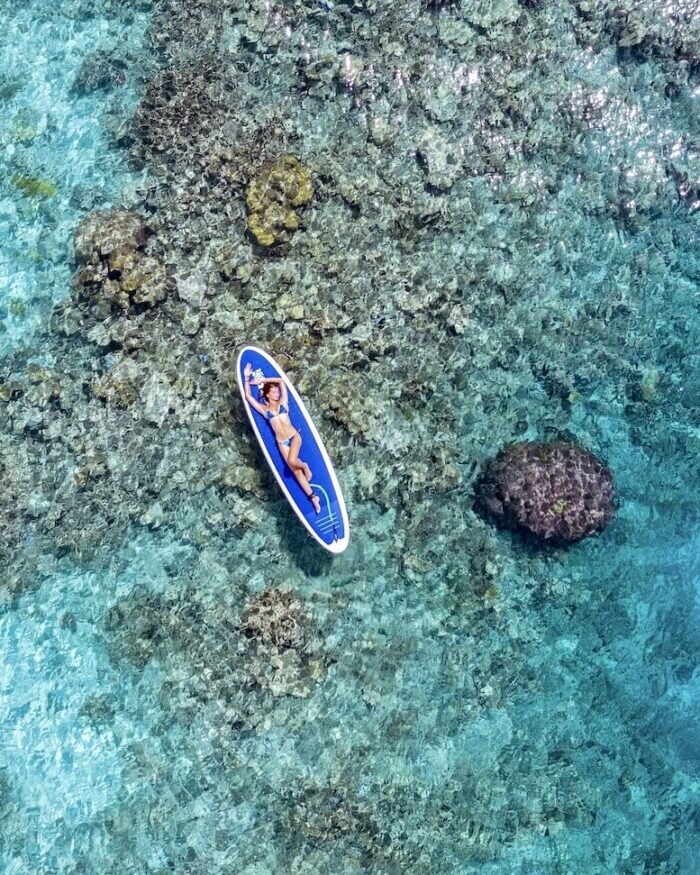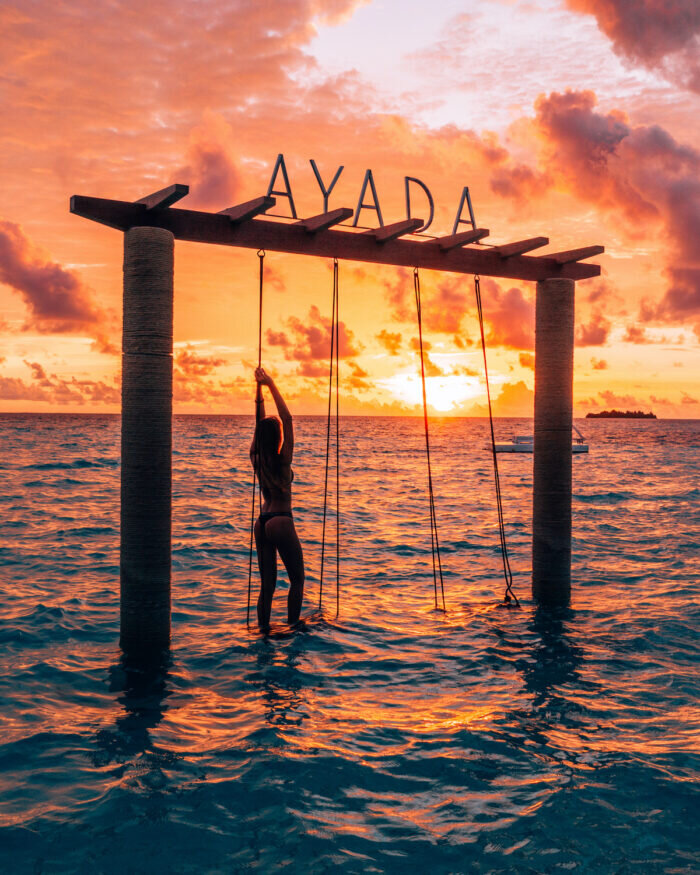What camera gear and accessories should you bring to your Maldives vacation?
Planning for the lifetime holidays in the Maldives? We are sure you would want to capture those incredible moments in photos that will last forever. Photos that you can share with your family and friends on your return home, or even live while you are enjoying paradise.
While smartphone cameras are okay to take average pictures, if you would like to capture impressive photos that are share-worthy, investing in a few simple gears might be a good idea.
With so much professional photography content on social media today, it will not take an adept photographer to spot if your photos are poorly taken. Here are our suggestions to choose the right camera gear and equipment for your stay at Ayada Maldives.
Pack a mirrorless camera
Mirrorless cameras have various advantages over DSLRs, particularly in low-light conditions. Even with the simplest mirrorless camera, you will be able to snap pro-level photos of anything after sunset, without fiddling minutes to find the right exposure, aperture, and ISO settings.
Any brand and make will do it, be it Sony, Canon, Nikon, or Pentax.
Some of the best experiences at Ayada Maldives are starting after dark, including dining, shows, entertainment, cocktails in Zero Degree, or simply stargazing on the beach. You would be sorry to miss out on these photo opportunities.
Using entry-level DSLR cameras such as Canon Rebel series, 80Ds, or similar pre-2018 models is likely to cause inconvenient moments.
Bright light
Daylight in the Maldives can be very bright. This is especially true here at Ayada Maldives. Due to the proximity to the equator, light can be too much to handle for cameras with a low dynamic range.
Saturated, intense colors
The colors of the tranquil nature can be intense, which might be challenging for cameras with small sensors. You definitely need a proper camera to capture the blue hues of the ocean, with clear whites as waves break, and those green palm trees in the background.
Sunsets
Sunsets which can be watched from the deck of your Villa or while sipping your favorite drink at our Poolside bar, are breath-taking. Especially if photographed by a capable camera. Once again, cameras with poor dynamic range will capture a red-orange mess instead of showing the true colors of sunsets.
Night photos
The clear, star-filled skies seen from our island are some of the most amazing sights you will experience. With a simple mobile phone camera, or with an old basic DSLR it will be nearly impossible to capture it.
What lens should you bring to the Maldives?
To take photos of yourself and your partner or family, we recommend using a 50mm lens. This focal length will give you a crisp image of the subject, as well as an artistic-looking background blur.
You will definitely need a zoom lens, as Ayada Maldives is home to a variety of interesting species that you probably won't see at home. We have Maldivian bats, also known as flying foxes, oriental garden lizards of many kinds, crabs - and parrots as well! Without a zoom lens, you would definitely miss out on many great photo opportunities.
If you like to take close-ups, consider bringing your 25mm lens. At Ayada Maldives you will never run out of close-up subjects. From Instagram-worthy cocktails to exotic tropical flowers and beautiful items in your villa, the island offers an amazing variety of close-up and macro subjects.
Bring your drone for aerial photos and videos
Ayada Maldives looks fascinating from the air. If you have a drone, make sure to bring it. To respect the privacy of our guests, using a drone over the villas is prohibited. No-drone zones are clearly indicated.
Using drones is allowed in most common areas, which enables one to take amazing aerial footage of our iconic lighthouse at the arrival jetty, the White Room wedding chapel, and most white-sand beach areas.
Underwater photography
When you snorkel or scuba dive in the Indian Ocean, you may see reef sharks, dolphins, turtles, manta rays, and hundreds of other species of colorful beautiful fish.
Not everyone is a fan of underwater photography, but since you come to one of the most beautiful and untouched Maldives islands, you will not want to miss out on snapping pictures under the ocean.
Bringing a bulky waterproof camera housing is inconvenient. Most of our photo-enthusiast guests do not do that. Picking up one of those few-hundred-dollar underwater cameras at the airport electronics shop is also not something we would recommend, as the picture quality of those is worse than an old smartphone camera.
If you do some research online, some travelers encourage each other to use their IP68 rated waterproof smartphones underwater. IP68 smartphones including iPhone and Samsung Galaxy S series are indeed usable in freshwater environments such as a swimming pool, but submerging in sea or ocean water is not recommended. Saltwater will cause oxidation and further damages to the speakers and charging port - reducing the lifetime of the device significantly.
GoPro is the best option
Instead of using smartphones underwater, bring a GoPro. The only issue you might face with a GoPro is the fish-eye effect, also known as the barrel effect that is caused by the wide-angle lens.
1. On the Camera
Shoot in a resolution that allows you to record using Linear FOV or (if your resolution/frame rate combination does not offer Linear) reduce the camera's Field of View (FOV) by zooming (or selecting Medium or Narrow on earlier model cameras). The level of barrel distortion increases as you move from the center of an image to the extremities. Shooting in a narrower FOV is akin to cropping the camera's image without the need to use editing software, cutting out the portions of the image that have the highest levels of distortion all by changing the FOV setting on the camera.
It's important to note that not all photo and video resolutions offer all FOV settings. Available settings are Narrow, Linear, Medium, Wide, and Superview.
2. Using GoPro Studio
GoPro Studio has a great, built-in Fisheye Removal Tool. It's similar to changing your camera's FOV, but with two key benefits:
It uses software to help straighten your footage out. There will still be slight cropping of your footage, but not to the same degree that you'll see when changing the camera's FOV.
Makes sure to bring a tripod, monopod, or a mini-tripod with adjustable angles
Unless you want to ask others to take photos of you, to be able to take photos with your partner or family, a tripod will be necessary.
Using a tripod of any size will help tremendously to set up great photo compositions. Additionally, it will also save significant time and frustration when taking nighttime photos - as using a tripod minimizes camera shake when pressing buttons on the device.
Bring a gimbal stabilizer for smooth video footages
If you plan to replicate some of the coolest footage that you can see on our Instagram and other social media feeds, you will definitely need a gimbal stabilizer. Even if you don't yet have one, it is a great idea to bring one along, as this device will enable you to record super smooth footage in motion, such as walking, panning, or even riding on one of our iconic white bicycles.
Gimbal stabilizers for smartphones are very affordable and widely available in most consumer electronics stores, as well as in most airports. If you prefer recording videos on your camera, you might want to bring a
DSLR or camera gimbal that is significantly larger and heavier, which might take unnecessary space in your luggage.
Some of the most successful content creators use smartphone gimbal stabilizers to record short clips, which will be seamlessly edited into their content. Further considering that most smartphones today have built-in camera stabilizers and are capable of 4k or even 8k video recording, we think that a smartphone gimbal stabilizer will be suitable for most situations.
Portable soft lights, or other LED lights
If you plan to take your Maldives photos to the next level, you definitely want to bring lights with you. Why do you need soft lights?
Sunset photos
Unless you only want to capture the silhouette of your partner during sunset, using lights is necessary. Built-in camera flashlights are harsh and aggressive, and using those for sunset photos will not get sharable results. Pointing soft lights to the face of the subject will create a significantly better light balance, and a more beautiful sunset photo.
Evening photos
Waking around the jungle pathways of Ayada Maldives will make you want to capture the moment. Considering the dim lighting, it will be challenging to take pictures that actually look somewhat professional, so using soft lights is recommended.
Travel-friendly portable soft lights are available in various shapes and sizes, from ultra-pocketable single-LED units to larger, inflatable ones with LED hue settings.
Wrapping up
Whatever your photo needs are, we definitely recommend making the best out of your photo opportunities while staying with us at Ayada Maldives. If you are not too much into photography, or not too particular about details then a smartphone camera will do the job.
If you do not wish to take your own photos, our resort photographer will be more than happy to arrange a session. This way you can be sure that you will have the best possible photos, that are worth keeping and sharing.




